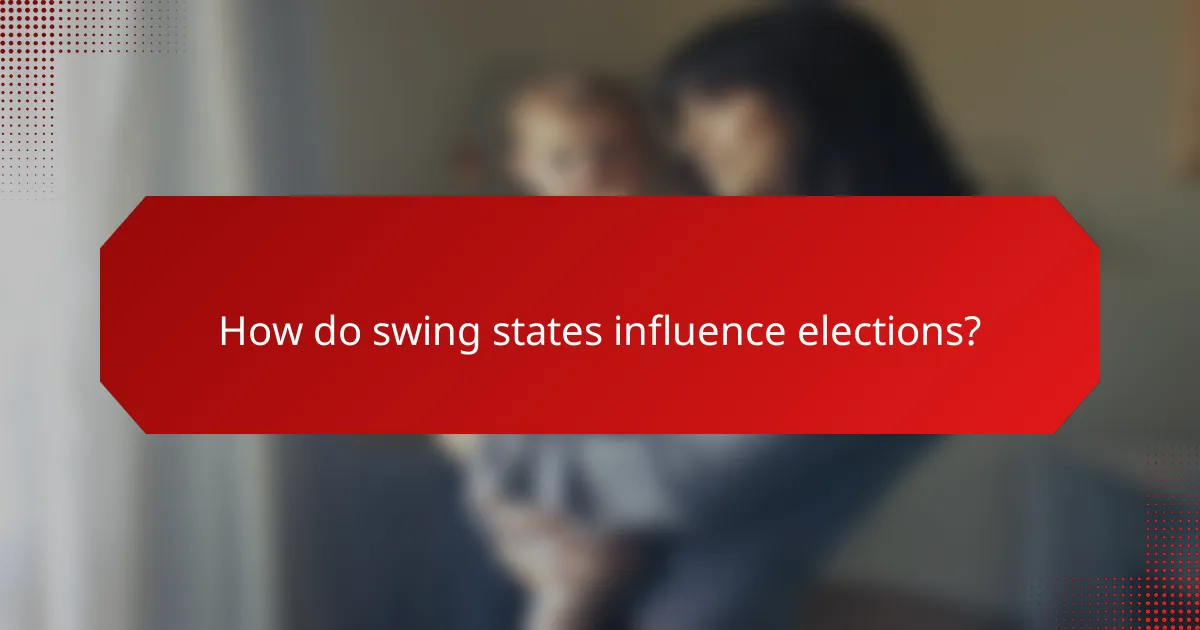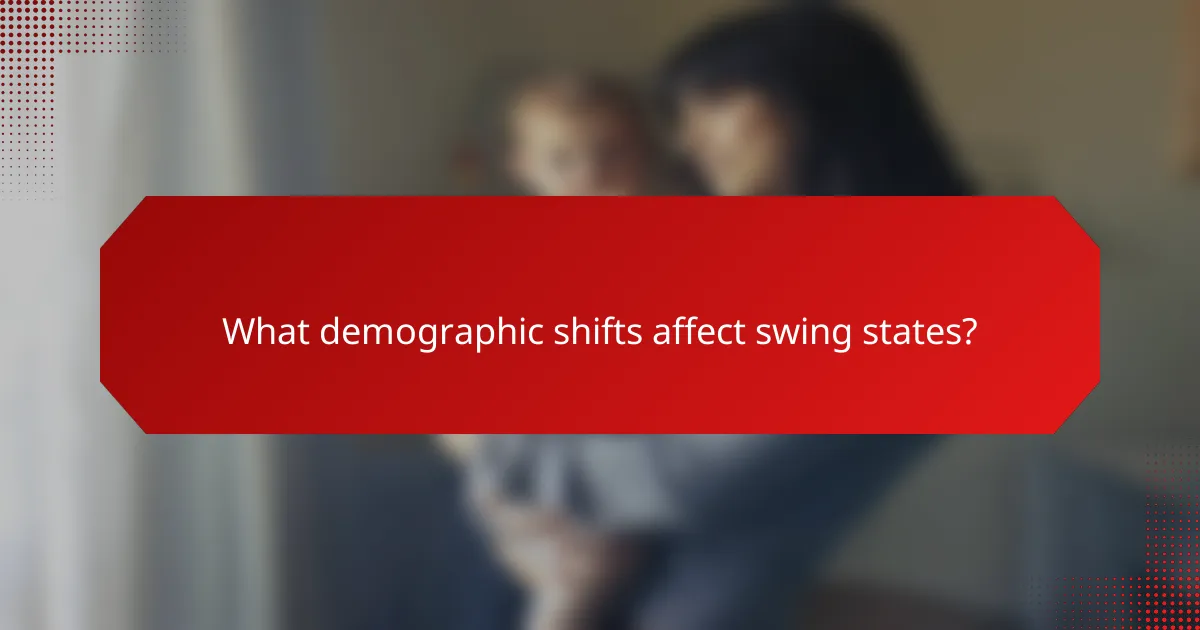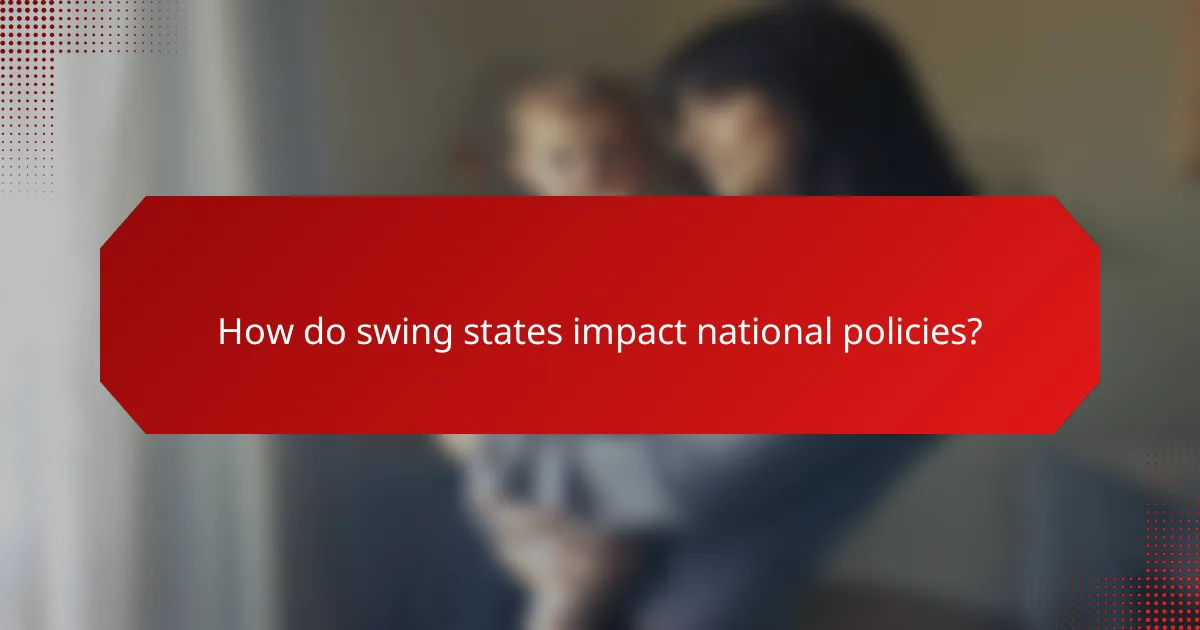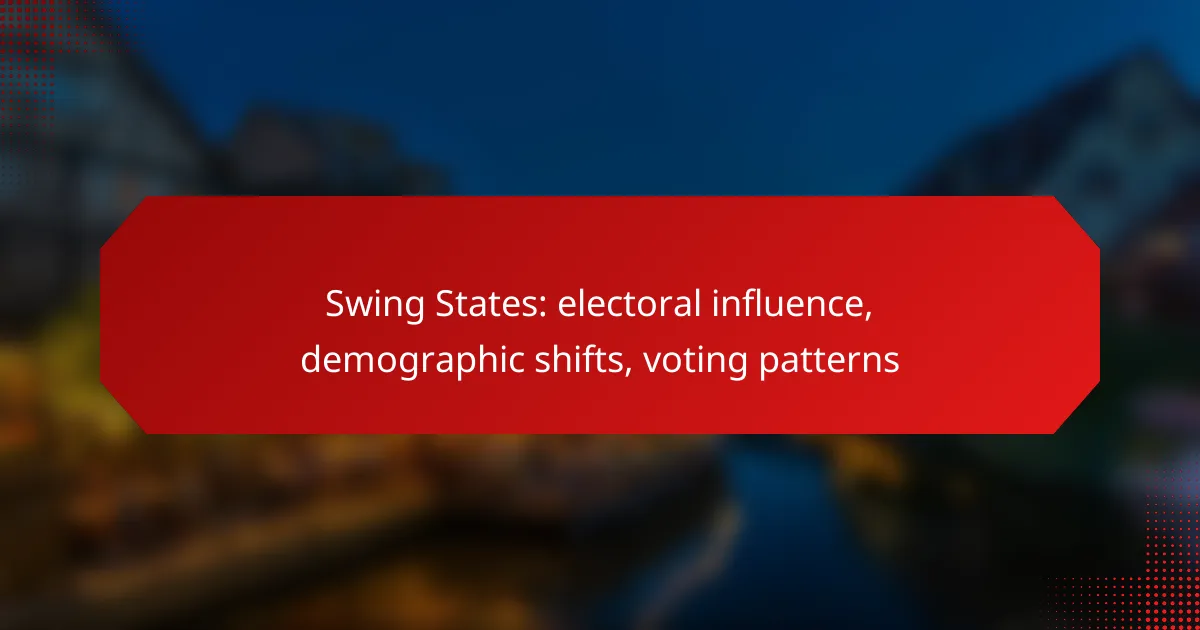Swing states are pivotal in elections, often deciding the outcome of closely contested races by shifting support between political parties. Demographic changes within these states, including variations in population, age, and urbanization, significantly impact voting patterns and preferences. As a result, swing states become essential battlegrounds for candidates aiming to secure a majority, reflecting the dynamic nature of the electorate.

How do swing states influence elections?
Swing states play a crucial role in elections by determining the outcome in closely contested races. These states can shift their support between political parties from one election to the next, making them key targets for candidates seeking to secure a majority.
Key swing states in recent elections
In recent elections, states like Florida, Pennsylvania, Wisconsin, and Michigan have emerged as significant swing states. Their electoral votes are often pivotal, with margins of victory frequently being razor-thin. For instance, Florida’s 29 electoral votes can sway a national election, given its diverse population and varying political preferences.
Other states, such as Arizona and Georgia, have also gained attention as swing states due to demographic shifts and changing voting patterns. These states illustrate how evolving populations can influence electoral dynamics.
Impact on electoral outcomes
The influence of swing states on electoral outcomes is profound, as they can determine which candidate secures the necessary electoral votes to win. Candidates often focus their campaigns on these states, tailoring their messages to resonate with local voters’ concerns and priorities.
Additionally, swing states can experience heightened campaign activity, including rallies, advertisements, and grassroots efforts. This concentrated attention can lead to increased voter turnout, further impacting election results.
Historical significance of swing states
Historically, swing states have been pivotal in shaping the political landscape of the United States. Elections in the past, such as the 2000 presidential election, showcased how a single state can alter the course of history through its electoral votes.
The patterns of swing states often reflect broader demographic and political trends, serving as indicators of shifting national sentiments. Understanding these trends can provide valuable insights into future elections and the evolving political climate.

What demographic shifts affect swing states?
Demographic shifts in swing states significantly influence electoral outcomes by altering the composition of the electorate. Changes in population size, age, race, and urbanization can lead to shifts in voting patterns and preferences, making these states critical in elections.
Population changes in key swing states
Key swing states often experience notable population changes due to migration trends, economic opportunities, and urban development. States like Florida and North Carolina have seen substantial growth from both domestic and international migration, impacting their electoral landscape.
For instance, Florida’s population has increased by millions over the past decade, with many new residents coming from other states and countries. This influx can shift the balance of power in elections, as new voters bring different priorities and perspectives.
Shifts in voter demographics
Voter demographics in swing states are evolving, with increasing diversity in age, race, and educational attainment. Younger voters, particularly those from minority backgrounds, are becoming a more significant portion of the electorate, influencing issues like climate change and social justice.
In states like Arizona and Georgia, the rise of these demographic groups has led to shifts in party alignment and voting behavior. For example, increased turnout among Hispanic and Black voters has been pivotal in recent elections, showcasing the importance of engaging these communities in the political process.

What are the voting patterns in swing states?
Voting patterns in swing states are characterized by fluctuating support for both major political parties, often influenced by demographic shifts and local issues. These states can determine the outcome of elections due to their unpredictable nature, making them a focal point for campaigns.
Trends in voter turnout
Voter turnout in swing states tends to be higher during presidential elections compared to midterm elections, often reaching over 60% in competitive races. Factors such as campaign engagement, voter mobilization efforts, and local issues significantly impact turnout rates.
In recent elections, swing states have seen increased participation from younger voters and minorities, reflecting broader demographic changes. This trend suggests that candidates must tailor their messages to resonate with these groups to enhance turnout.
Party affiliation changes
Party affiliation in swing states is dynamic, with many voters identifying as independents or switching allegiance between elections. This fluidity can be attributed to changing economic conditions, social issues, and candidate appeal.
In recent years, some swing states have experienced a shift towards the Democratic Party, particularly in suburban areas, while others have leaned Republican due to rural voter mobilization. Understanding these shifts is crucial for candidates aiming to secure votes in these pivotal regions.

How do swing states affect campaign strategies?
Swing states play a crucial role in shaping campaign strategies as they can decisively influence the outcome of elections. Candidates focus their efforts on these states to sway undecided voters, tailoring their messages and resources to address local concerns and demographics.
Targeted messaging in swing states
In swing states, candidates craft targeted messaging that resonates with the unique demographics and issues of the region. This often involves addressing local economic concerns, social issues, or cultural values that may differ significantly from those in solidly partisan states.
For example, a candidate might emphasize job creation in a swing state with high unemployment, while focusing on healthcare reforms in a state where access to medical services is a pressing issue. This localized approach helps candidates connect with voters on a personal level.
Resource allocation by candidates
Candidates allocate resources strategically in swing states, often investing more in advertising, campaign events, and grassroots organizing. This can mean deploying larger teams of volunteers and staff to engage voters directly, as well as increasing spending on local media.
Typically, candidates might spend millions of dollars on campaign ads in these states, focusing on key demographics such as independents and moderates. This concentrated effort aims to maximize voter turnout and sway undecided voters, making every dollar spent critical to their overall strategy.

What are the criteria for identifying swing states?
Swing states are identified based on their potential to be won by either major political party in an election. Key criteria include polling data, voting history, and demographic shifts that indicate fluctuating voter preferences.
Polling data analysis
Polling data is crucial for identifying swing states, as it reflects current voter sentiment and potential election outcomes. Analysts look for states where polls show close margins between candidates, typically within a few percentage points.
It’s important to consider multiple polls over time to assess trends rather than relying on a single data point. States like Pennsylvania and Wisconsin often show variability in polls, making them prime examples of swing states.
Voting history evaluation
Evaluating voting history helps to understand a state’s political landscape. Swing states often have a history of voting for both major parties in different elections, indicating a lack of strong partisan loyalty.
For instance, states such as Florida and North Carolina have shifted between Democratic and Republican candidates in recent elections, highlighting their status as battlegrounds. Analyzing past election results can provide insights into potential future outcomes and voter behavior.

How do swing states impact national policies?
Swing states play a crucial role in shaping national policies by influencing electoral outcomes. Their unpredictable voting patterns can sway the balance of power in Congress and the presidency, prompting candidates to tailor their platforms to appeal to these pivotal regions.
Policy shifts based on swing state outcomes
When swing states determine election results, the winning party often prioritizes policies that resonate with the demographics and interests of those states. For instance, if a swing state with a significant agricultural sector votes for a particular candidate, that candidate may push for farm subsidies or trade policies favorable to agriculture.
Additionally, the outcomes in these states can lead to shifts in social policies, such as healthcare or education reform, reflecting the preferences of voters in those areas. Candidates may adopt more moderate positions to attract undecided voters, resulting in policies that are less partisan and more centrist.
Influence on federal legislation
Swing states can significantly influence federal legislation by affecting the composition of Congress. When representatives from these states hold key committee positions, they can champion legislation that aligns with their constituents’ needs, often leading to bipartisan support.
For example, if a swing state elects a senator who prioritizes infrastructure development, this can lead to increased federal funding for projects in that state and similar regions. Lawmakers may also negotiate compromises on contentious issues to secure votes from swing state representatives, further shaping national policies.

What are the emerging trends in swing state politics?
Emerging trends in swing state politics highlight the increasing influence of independent voters and the significant role of social media in voter engagement. These factors are reshaping traditional voting patterns and demographic influences in key electoral battlegrounds.
Rise of independent voters
The rise of independent voters is a notable trend in swing states, as more individuals are identifying as politically unaffiliated rather than aligning strictly with the two major parties. This shift can lead to unpredictable election outcomes, as independents often hold the balance of power in closely contested races.
In recent elections, independent voters have shown a tendency to prioritize issues over party loyalty, making them more responsive to candidates who address their specific concerns. Campaigns that focus on local issues, economic stability, and healthcare tend to resonate well with this demographic.
Impact of social media on voter engagement
Social media has transformed voter engagement in swing states by providing platforms for direct communication between candidates and constituents. This immediacy allows voters to interact with campaigns in real time, shaping opinions and mobilizing support more effectively than traditional media.
Campaigns that leverage social media can reach diverse audiences, particularly younger voters who are more likely to engage online. However, candidates must be cautious about misinformation and ensure their messaging is clear and accurate to maintain credibility among voters.

What future developments can we expect in swing state dynamics?
Future developments in swing state dynamics will likely be shaped by ongoing demographic shifts, evolving voting patterns, and changes in political engagement. Understanding these trends is crucial for predicting electoral outcomes in these pivotal regions.
Predicted demographic changes
Demographic changes in swing states are expected to significantly influence electoral dynamics. Factors such as urbanization, migration patterns, and shifts in age distribution will play key roles in shaping the electorate.
For instance, states like Arizona and Georgia have seen an influx of younger, more diverse populations, which may lead to a shift in voting preferences. This trend could result in increased support for progressive candidates and policies, altering the traditional political landscape.
Additionally, as suburban areas continue to grow, the demographics within these regions may shift towards more moderate or liberal views, impacting local and national elections. Monitoring these changes will be essential for political strategists aiming to understand and engage with voters effectively.
